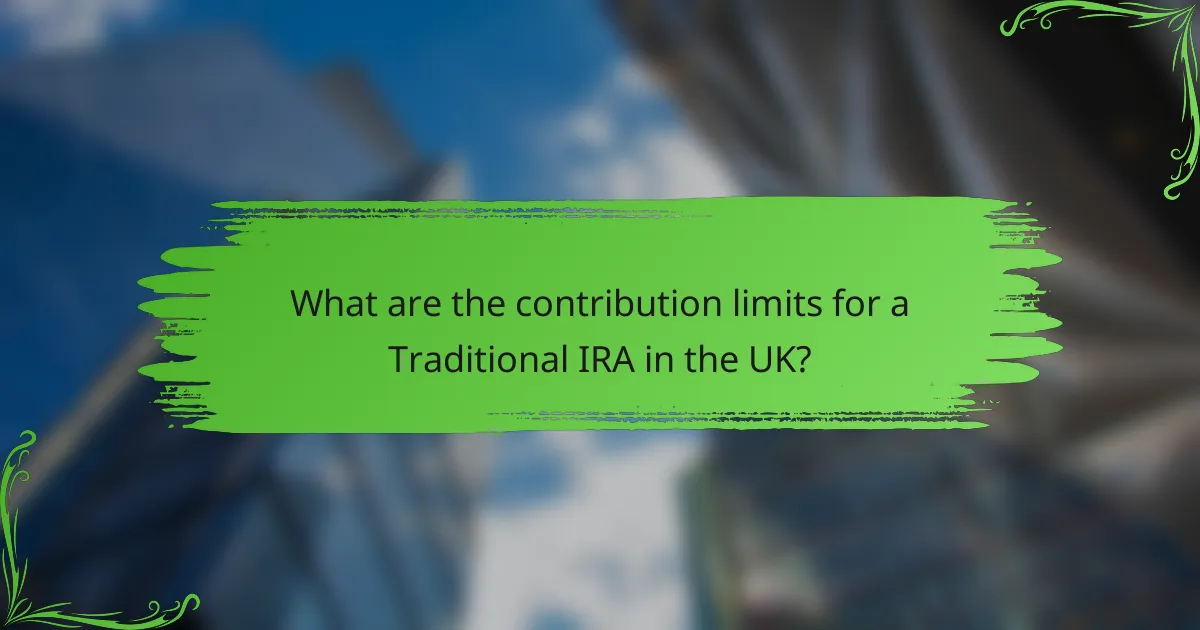A Traditional IRA, or personal pension in the UK, involves various annual fees that can affect your investment returns, including maintenance and management fees. Contribution limits are determined by government-set annual allowances, which may change with fiscal policies. Additionally, the investment costs associated with a Traditional IRA can vary widely, encompassing fund expense ratios, brokerage fees, and advisory service charges.

What are the annual fees for a Traditional IRA in the UK?
The annual fees for a Traditional IRA in the UK can vary significantly based on the provider and the specific services offered. Generally, these fees may include maintenance fees, account management fees, and other associated costs, which can impact your overall investment returns.
Typical annual maintenance fees
Annual maintenance fees for a Traditional IRA in the UK typically range from £0 to £300, depending on the financial institution. Some providers may offer accounts with no maintenance fees, while others charge a flat fee or a percentage of the account balance.
It’s essential to compare different providers to find a plan that aligns with your investment strategy and financial goals. Look for options that minimize these fees while still offering the necessary services.
Common account management fees
Account management fees can vary widely, often falling between 0.5% to 1.5% of the assets under management. These fees cover the costs associated with managing your investments, including trading costs and advisory services.
Some providers may charge additional fees for specific transactions, such as buying or selling investments. Always review the fee schedule before opening an account to avoid unexpected charges.
Impact of account balance on fees
The impact of your account balance on fees can be significant. Many providers offer tiered fee structures, where higher balances may qualify for lower percentage fees. For instance, accounts with balances above £50,000 might incur lower fees compared to those with smaller balances.
Additionally, some institutions may waive maintenance fees if your balance exceeds a certain threshold. Understanding these structures can help you choose the right provider and optimize your investment costs.

What are the contribution limits for a Traditional IRA in the UK?
In the UK, the contribution limits for a Traditional IRA, often referred to as a personal pension, are primarily influenced by annual allowances set by the government. For the tax year, individuals can contribute up to a certain limit, which is subject to change based on fiscal policies.
Annual contribution limits for individuals
The annual contribution limit for individuals to a Traditional IRA in the UK is typically set at £40,000. This limit applies to the total contributions made to all pension schemes in a tax year. If contributions exceed this limit, individuals may face tax penalties on the excess amount.
Catch-up contribution limits for older savers
For individuals aged 50 and over, there are provisions for catch-up contributions, allowing them to save more for retirement. While the standard limit remains at £40,000, older savers can contribute an additional £10,000, bringing their total potential contribution to £50,000 annually.
Income phase-out ranges for contributions
The ability to contribute to a Traditional IRA may be affected by income levels. For high earners, the contribution limits can phase out based on their adjusted gross income (AGI). Generally, if an individual’s AGI exceeds £200,000, their ability to make full contributions may be reduced, impacting their retirement savings strategy.

What are the investment costs associated with a Traditional IRA?
The investment costs associated with a Traditional IRA can vary significantly based on the type of investments you choose and the services you utilize. Key costs include fund expense ratios, brokerage fees for trades, and the potential cost of financial advisory services.
Typical fund expense ratios
Fund expense ratios represent the annual fees charged by mutual funds or exchange-traded funds (ETFs) to manage your investments. These ratios typically range from around 0.1% to over 1% of your investment, depending on the fund type and management style. Index funds generally have lower expense ratios compared to actively managed funds.
When selecting funds for your Traditional IRA, consider how these expense ratios will impact your overall returns over time. Even small differences in fees can compound significantly, especially over long investment horizons.
Brokerage fees for trades
Brokerage fees are charges incurred when buying or selling investments within your Traditional IRA. Many brokerages now offer commission-free trading for stocks and ETFs, but fees may apply for mutual fund transactions or other specialized services. It’s essential to review your brokerage’s fee schedule to understand any costs that may arise.
To minimize trading costs, consider using a brokerage that offers a wide range of commission-free options. This can help you keep more of your investment returns, especially if you plan to make frequent trades.
Cost of financial advisory services
If you choose to work with a financial advisor for your Traditional IRA, be aware of the associated costs. Advisors may charge a flat fee, an hourly rate, or a percentage of assets under management, typically ranging from 0.5% to 2% annually. Understanding these fees is crucial, as they can significantly affect your investment growth.
Before hiring an advisor, clarify their fee structure and what services are included. Some advisors may offer comprehensive financial planning, while others focus solely on investment management. Ensure their services align with your investment goals and budget.

How do Traditional IRA fees compare to other retirement accounts?
Traditional IRA fees are generally competitive compared to other retirement accounts, but they can vary significantly based on the financial institution and investment choices. Understanding these fees is crucial for maximizing your retirement savings and minimizing costs.
Comparison with Roth IRA fees
Both Traditional and Roth IRAs often have similar fee structures, including account maintenance fees, investment fees, and transaction costs. However, Roth IRAs may have slightly higher fees due to the potential for more diverse investment options and tax-free growth. It’s essential to compare specific account offerings to determine which option aligns better with your financial goals.
For instance, some providers may charge a flat annual fee for both account types, while others might offer no-fee options for Roth IRAs. Always review the fee schedule before opening an account to avoid unexpected costs.
Comparison with 401(k) fees
401(k) plans typically have higher fees than Traditional IRAs, primarily due to administrative costs and the employer’s plan management. While some 401(k) accounts may offer lower investment fees due to bulk purchasing power, they often come with additional charges like plan management fees that can diminish your returns over time.
For example, average 401(k) fees can range from 0.5% to 2% of assets annually, while Traditional IRA fees might be lower, often below 1%. Evaluating the total cost of your retirement accounts is essential to ensure you are not overpaying for investment management.

What factors should you consider when choosing a Traditional IRA provider?
When selecting a Traditional IRA provider, consider fees, investment options, and customer service. These factors can significantly impact your retirement savings and overall experience.
Fee structures and transparency
Understanding the fee structures of different Traditional IRA providers is crucial. Common fees include account maintenance fees, trading commissions, and expense ratios for mutual funds. Look for providers that offer clear and transparent fee disclosures to avoid unexpected costs.
Many providers charge annual fees that can range from $0 to several hundred dollars, depending on the services offered. It’s advisable to compare these fees across different institutions to find the most cost-effective option.
Investment options available
The variety of investment options can vary significantly between Traditional IRA providers. Some may offer a wide range of assets, including stocks, bonds, ETFs, and mutual funds, while others may have limited selections. Choose a provider that aligns with your investment strategy and goals.
Consider whether the provider allows for self-directed investments, which can give you more control over your portfolio. Additionally, check if they offer any specialized investment options, such as socially responsible funds or target-date funds.
Customer service and support
Good customer service is essential when managing a Traditional IRA. Look for providers that offer multiple channels for support, such as phone, email, and live chat. Responsive customer service can help you resolve issues quickly and efficiently.
Research customer reviews and ratings to gauge the quality of service offered by potential providers. A provider with strong customer support can make a significant difference in your overall experience, especially when navigating complex retirement planning questions.

What are the tax implications of a Traditional IRA in the UK?
A Traditional IRA in the UK offers tax advantages primarily through tax deductions on contributions and tax treatment on withdrawals. Understanding these implications is essential for effective retirement planning.
Tax deductions on contributions
Contributions to a Traditional IRA may be tax-deductible, reducing your taxable income for the year. The deduction amount can vary based on your income level and whether you or your spouse are covered by a workplace pension scheme.
For the tax year, individuals can typically contribute up to a certain limit, which is often set around £3,600 for those under 75. If you exceed this limit, you may face tax penalties, so it’s crucial to stay informed about the current thresholds.
Taxation on withdrawals
Withdrawals from a Traditional IRA are generally subject to income tax at your current tax rate. This means that the amount you take out will be added to your taxable income for that year, potentially pushing you into a higher tax bracket.
If you withdraw funds before the age of 55, you may incur additional penalties, typically around 25% of the amount withdrawn. Planning your withdrawals strategically can help minimize tax liabilities and penalties, ensuring you make the most of your retirement savings.

What are the penalties for early withdrawal from a Traditional IRA?
Withdrawing funds from a Traditional IRA before reaching age 59½ typically incurs a penalty. The standard penalty is 10% of the amount withdrawn, in addition to any applicable income taxes on the distribution.
Standard early withdrawal penalties
The standard penalty for early withdrawal from a Traditional IRA is 10% of the amount taken out. This penalty is assessed on top of regular income tax, which means the total tax burden can be significant. For example, if you withdraw $10,000 early, you could face a $1,000 penalty plus income tax on that amount.
There are exceptions to this penalty, such as for first-time home purchases, certain medical expenses, or if you become disabled. Understanding these exceptions can help you avoid unnecessary penalties when accessing your funds early.
Considerations for early withdrawals
Before making an early withdrawal, consider the long-term impact on your retirement savings. Removing funds reduces your investment growth potential, which can significantly affect your retirement nest egg. It’s crucial to weigh the immediate need for cash against the future benefits of keeping your IRA intact.
Consulting a financial advisor can provide personalized insights based on your situation. They can help you explore alternatives to early withdrawal, such as loans or other financial products that may better suit your needs without incurring penalties.


